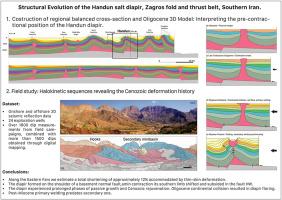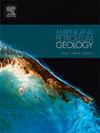Structural evolution of the Handun salt diapir, Zagros fold and thrust belt, southern Iran
IF 3.7
2区 地球科学
Q1 GEOSCIENCES, MULTIDISCIPLINARY
引用次数: 0
Abstract
The Fars region, in the Zagros fold and thrust belt, hosts a wide range of diapirs piercing over 10 km of stratigraphic sequence. Comprising Precambrian to Early-Cambrian Hormuz Salt, these diapirs exhibit a prolonged history of evolution. Outcrop evidence for understanding the diapir deformation history is mostly limited to the Cenozoic contractive phase, and the seismic data lacks the necessary quality for an exhaustive understanding of the deepest structure's geometries. Through regional and field evidence we unravel the Handun salt structure evolution and propose a sequential restoration to describe the key deformational events. Our study presents a field-based novel regional balanced cross-section and a 3D-geological model, and addresses the role of structural inheritances and the position of the Handun diapir with respect to the decupled basement. The performed field studies describe folds and unconformities related to Cenozoic halokinetic sequences with exceptional clarity. It was possible to observe changes of the diapir activity along the structure and provide field evidence for the relative timing and kinematics of primary and secondary welding. Finally, our data suggest that the Handun diapir formed in the early Paleozoic above the shoulder of a basement extensional fault, and was partially translated above its southern hanging-wall during the shortening. In the Paleocene a sustained ratio of salt rise rate was enhanced by the Zagros/Oman contraction. In response to the Oligocene continental collision, the diapir was profusely supplied with salt, which flared upward to form overhangs. Since the middle Miocene the salt supply slowly depleted, with the diapiric walls remaining near the surface but tapering upward, probably due to primary welding or increased sedimentation. Secondary welding occurred post-Pliocene in the last stages of the diapir evolution with consequent development of a secondary minibasin.

伊朗南部扎格罗斯褶皱和推力带汉墩盐丘的构造演化
位于扎格罗斯褶皱和推力带的法尔斯地区有许多穿透 10 多公里地层序列的地下断裂带。这些断裂带包括前寒武纪至早寒武纪的霍尔木兹盐岩,呈现出漫长的演化历史。用于了解斜坡变形历史的外露证据大多局限于新生代的收缩阶段,而地震数据缺乏必要的质量,无法详尽了解最深结构的几何形状。通过区域和野外证据,我们揭示了韩墩盐构造的演化过程,并提出了描述关键变形事件的序列复原方法。我们的研究提出了基于野外的新型区域平衡横截面和三维地质模型,并探讨了结构继承的作用以及韩墩断裂带相对于减厚基底的位置。所进行的实地研究非常清晰地描述了与新生代卤化序列有关的褶皱和不整合。我们有可能观察到该构造沿线的断裂活动变化,并为原生焊接和次生焊接的相对时间和运动学提供了实地证据。最后,我们的数据表明,韩墩断裂形成于古生代早期,位于基底伸展断层的肩部之上,在缩短过程中被部分平移到其南悬壁之上。在古新世,由于扎格罗斯/阿曼收缩,盐的上升率持续增加。随着渐新世大陆碰撞的发生,断裂带得到了大量的盐分供应,并向上扩展形成悬壁。从中新世中期开始,盐分供应慢慢枯竭,可能由于原生焊接或沉积作用的增加,陡崖壁仍然靠近地表,但向上逐渐变细。次生焊接发生在始新世后,即沼泽演变的最后阶段,随之形成了次生小盆地。
本文章由计算机程序翻译,如有差异,请以英文原文为准。
求助全文
约1分钟内获得全文
求助全文
来源期刊

Marine and Petroleum Geology
地学-地球科学综合
CiteScore
8.80
自引率
14.30%
发文量
475
审稿时长
63 days
期刊介绍:
Marine and Petroleum Geology is the pre-eminent international forum for the exchange of multidisciplinary concepts, interpretations and techniques for all concerned with marine and petroleum geology in industry, government and academia. Rapid bimonthly publication allows early communications of papers or short communications to the geoscience community.
Marine and Petroleum Geology is essential reading for geologists, geophysicists and explorationists in industry, government and academia working in the following areas: marine geology; basin analysis and evaluation; organic geochemistry; reserve/resource estimation; seismic stratigraphy; thermal models of basic evolution; sedimentary geology; continental margins; geophysical interpretation; structural geology/tectonics; formation evaluation techniques; well logging.
 求助内容:
求助内容: 应助结果提醒方式:
应助结果提醒方式:


